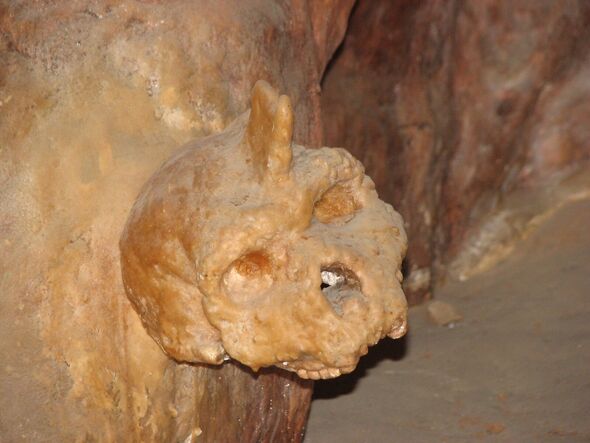Science
Ancient Skull Mystery Unraveled: New Evidence Dates Fossil to 286,000 Years

The long-standing mystery surrounding the 286,000-year-old skull discovered in the Petralona Cave in Greece has taken a significant turn, as researchers have made strides in determining its age and place in human evolution. This ancient skull, unearthed by local villager Christos Sariannidis in 1960, has puzzled scientists for decades due to its unique characteristics that differentiate it from both Neanderthals and modern humans.
The Petralona Cave, located approximately 35 kilometers southeast of Thessaloniki, has been a site of intrigue for palaeoanthropologists. The skull belongs to a member of the Homo genus, but its distinct traits suggest it is part of a more primitive group than both Homo sapiens and Neanderthals. Until now, researchers faced challenges in determining a precise dating for the skull, with previous estimates ranging from 170,000 to 700,000 years old.
New Research Provides Clarity
A recent study conducted by the Institut de Paléontologie Humaine has utilized advanced U-series dating techniques to establish a minimum age for the skull. The findings, detailed in the paper “New U-series dates on the Petralona cranium, a key fossil in European human evolution,” indicate that the skull is at least 286,000 years old, with a margin of error of ±9,000 years.
U-series dating employs natural properties of uranium isotopes, which decay into thorium at a known rate. By analyzing the ratio of uranium to thorium in the calcite deposits that formed on the skull, researchers were able to pinpoint when these processes began. The method provides a reliable timeline, as uranium isotopes break down into thorium in a closed system, offering a minimum starting date for the fossil.
The results suggest that if the skull remained dry or covered, it could have been in the cave for an even longer period. This discovery reinforces the idea that the Petralona hominin coexisted with an evolving Neanderthal lineage during the later phases of the Middle Pleistocene in Europe.
Comparative Anatomy and Implications
The nearly complete cranium, though missing its lower jaw, shares similarities with other significant fossils, including those found at Arago in France, Bodo in Ethiopia, and Kabwe in Zambia. These specimens demonstrate traits akin to Homo erectus, such as prominent brow ridges and robust skull features, while also exhibiting attributes associated with later Homo species, including a comparatively larger brain.
Researchers at the Geology School of the Aristotle University of Thessaloniki have preserved the skull since its initial discovery. The recent findings not only contribute to the understanding of human evolution but also highlight the complexity of our ancestry. The distinct characteristics of the Petralona skull suggest that it is part of a unique lineage, raising intriguing questions about the interactions and coexistence of early human populations in Europe.
This breakthrough in archaeological research marks a significant step forward in unraveling the mysteries of our ancient past, illustrating the ongoing journey of discovery in the field of human evolution. As scientists continue to study this fascinating specimen, the Petralona skull remains a key piece in the puzzle of human history.
-

 Entertainment2 weeks ago
Entertainment2 weeks agoAndrew Pierce Confirms Departure from ITV’s Good Morning Britain
-

 Health4 months ago
Health4 months agoNeurologist Warns Excessive Use of Supplements Can Harm Brain
-

 Health4 months ago
Health4 months agoFiona Phillips’ Husband Shares Heartfelt Update on Her Alzheimer’s Journey
-

 Science2 months ago
Science2 months agoBrian Cox Addresses Claims of Alien Probe in 3I/ATLAS Discovery
-

 Science2 months ago
Science2 months agoNASA Investigates Unusual Comet 3I/ATLAS; New Findings Emerge
-

 Entertainment1 week ago
Entertainment1 week agoGogglebox Star Helena Worthington Announces Break After Loss
-

 Entertainment1 month ago
Entertainment1 month agoTess Daly Honoured with MBE, Announces Departure from Strictly
-

 Science2 months ago
Science2 months agoScientists Examine 3I/ATLAS: Alien Artifact or Cosmic Oddity?
-

 Entertainment3 months ago
Entertainment3 months agoLewis Cope Addresses Accusations of Dance Training Advantage
-

 Entertainment5 months ago
Entertainment5 months agoKerry Katona Discusses Future Baby Plans and Brian McFadden’s Wedding
-

 Science2 months ago
Science2 months agoNASA Investigates Speedy Object 3I/ATLAS, Sparking Speculation
-

 Entertainment5 months ago
Entertainment5 months agoEmmerdale Faces Tension as Dylan and April’s Lives Hang in the Balance









